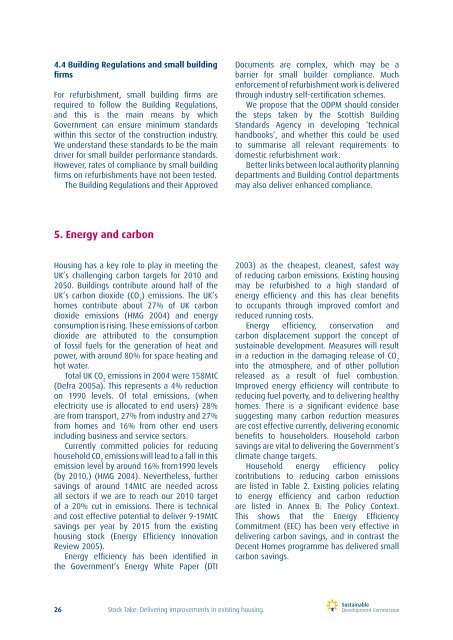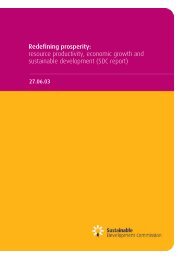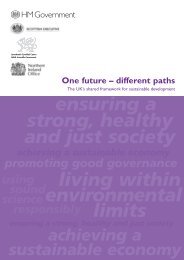Stock Take - Sustainable Development Commission
Stock Take - Sustainable Development Commission
Stock Take - Sustainable Development Commission
- No tags were found...
You also want an ePaper? Increase the reach of your titles
YUMPU automatically turns print PDFs into web optimized ePapers that Google loves.
4.4 Building Regulations and small buildingfirmsFor refurbishment, small building firms arerequired to follow the Building Regulations,and this is the main means by whichGovernment can ensure minimum standardswithin this sector of the construction industry.We understand these standards to be the maindriver for small builder performance standards.However, rates of compliance by small buildingfirms on refurbishments have not been tested.The Building Regulations and their ApprovedDocuments are complex, which may be abarrier for small builder compliance. Muchenforcement of refurbishment work is deliveredthrough industry self-certification schemes.We propose that the ODPM should considerthe steps taken by the Scottish BuildingStandards Agency in developing ‘technicalhandbooks’, and whether this could be usedto summarise all relevant requirements todomestic refurbishment work.Better links between local authority planningdepartments and Building Control departmentsmay also deliver enhanced compliance.5. Energy and carbonHousing has a key role to play in meeting theUK’s challenging carbon targets for 2010 and2050. Buildings contribute around half of theUK’s carbon dioxide (CO 2) emissions. The UK’shomes contribute about 27% of UK carbondioxide emissions (HMG 2004) and energyconsumption is rising. These emissions of carbondioxide are attributed to the consumptionof fossil fuels for the generation of heat andpower, with around 80% for space heating andhot water.Total UK CO 2emissions in 2004 were 158MtC(Defra 2005a). This represents a 4% reductionon 1990 levels. Of total emissions, (whenelectricity use is allocated to end users) 28%are from transport, 27% from industry and 27%from homes and 16% from other end usersincluding business and service sectors.Currently committed policies for reducinghousehold CO 2emissions will lead to a fall in thisemission level by around 16% from1990 levels(by 2010,) (HMG 2004). Nevertheless, furthersavings of around 14MtC are needed acrossall sectors if we are to reach our 2010 targetof a 20% cut in emissions. There is technicaland cost effective potential to deliver 9-19MtCsavings per year by 2015 from the existinghousing stock (Energy Efficiency InnovationReview 2005).Energy efficiency has been identified inthe Government’s Energy White Paper (DTI2003) as the cheapest, cleanest, safest wayof reducing carbon emissions. Existing housingmay be refurbished to a high standard ofenergy efficiency and this has clear benefitsto occupants through improved comfort andreduced running costs.Energy efficiency, conservation andcarbon displacement support the concept ofsustainable development. Measures will resultin a reduction in the damaging release of CO 2into the atmosphere, and of other pollutionreleased as a result of fuel combustion.Improved energy efficiency will contribute toreducing fuel poverty, and to delivering healthyhomes. There is a significant evidence basesuggesting many carbon reduction measuresare cost effective currently, delivering economicbenefits to householders. Household carbonsavings are vital to delivering the Government’sclimate change targets.Household energy efficiency policycontributions to reducing carbon emissionsare listed in Table 2. Existing policies relatingto energy efficiency and carbon reductionare listed in Annex B: The Policy Context.This shows that the Energy EfficiencyCommitment (EEC) has been very effective indelivering carbon savings, and in contrast theDecent Homes programme has delivered smallcarbon savings.26 <strong>Stock</strong> <strong>Take</strong>: Delivering improvements in existing housing.








